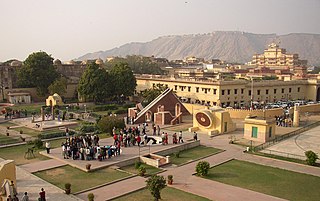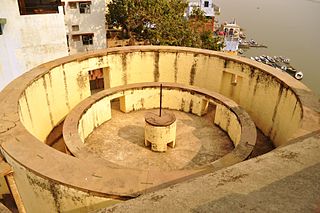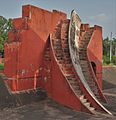
Jaipur, formerly Jeypore, is the capital and largest city of the Indian state of Rajasthan. As of 2011, the city had a population of 3.1 million, making it the tenth most populous city in the country. Jaipur is also known as the Pink City, due to the dominant colour scheme of its buildings. It is also known as the Paris of India, and C. V. Raman called it the Island of Glory. It is located 268 km from the national capital New Delhi. Jaipur was founded in 1727 by the Kachhwaha Rajput ruler Jai Singh II, the ruler of Amer, after whom the city is named. It was one of the earliest planned cities of modern India, designed by Vidyadhar Bhattacharya. During the British Colonial period, the city served as the capital of Jaipur State. After independence in 1947, Jaipur was made the capital of the newly formed state of Rajasthan.
The year 1727 in science and technology involved some significant events.
Paṇḍita Jagannātha Samrāṭ (1652–1744) was an Indian astronomer and mathematician who served in the court of Jai Singh II of Amber, and was also his guru.

Jai Singh II popularly known as Sawai Raja Jai Singh was the 29th Kachwaha ruler of the Kingdom of Amber, who later founded the fortified city of Jaipur and made it his capital. He was born at Amber, the capital of the Kachwaha. He became ruler of Amber at the age of 11 after the death of his father, Raja Bishan Singh on 31 December 1699.

The Hawa Mahal is a palace in the city of Jaipur, India. Built from red and pink sandstone, it is on the edge of the City Palace, Jaipur, and extends to the Zenana, or women's chambers.

The Kachhwaha, or Kachawa is a Rajput clan found primarily in India.

The Jantar Mantar, Jaipur is a collection of 19 astronomical instruments built by the Rajput king Sawai Jai Singh, the founder of Jaipur, Rajasthan. The monument was completed in 1734. It features the world's largest stone sundial, and is a UNESCO World Heritage Site. It is near City Palace and Hawa Mahal. The instruments allow the observation of astronomical positions with the naked eye. The observatory is an example of the Ptolemaic positional astronomy which was shared by many civilizations.

Indian astronomy refers to astronomy practiced in Indian subcontinent. It has a long history stretching from pre-historic to modern times. Some of the earliest roots of Indian astronomy can be dated to the period of Indus Valley civilisation or earlier. Astronomy later developed as a discipline of Vedanga, or one of the "auxiliary disciplines" associated with the study of the Vedas dating 1500 BCE or older. The oldest known text is the Vedanga Jyotisha, dated to 1400–1200 BCE.

Hanuman Temple in Connaught Place, New Delhi, India, is an ancient Hindu temple and is claimed to be one of the five temples of Mahabharata days in Delhi. The other four temples are the Kalkaji, a Kali temple in South Delhi containing Swayambu rock Idol, the Yogmaya Temple near Qutub Minar, the Bhairav temple near the Purana Qila and the Nili Chatri Mahadev at Nigambodh Ghat outside the walls of Old Delhi.
Ujjain is an ancient city of central India, in the Malwa region of the Indian state of Madhya Pradesh, on the eastern bank of the Kshipra River.

A Jantar Mantar is an assembly of stone-built astronomical instruments, designed to be used with the naked eye. There were five Jantar Mantars in India. All were built at the command of the Rajah Jai Singh II, who had a keen interest in mathematics, architecture and astronomy. The largest example is the equinoctial sundial belonging to Jaipur's assembly of instruments, consisting of a gigantic triangular gnomon with the hypotenuse parallel to the Earth's axis. On either side of the gnomon is a quadrant of a circle, parallel to the plane of the equator. The instrument can be used with an accuracy of about 20 seconds by a skilled observer to determine the time of day, and the declination of the Sun and the other heavenly bodies. It is the world's largest stone sundial, and is known as the Samrat Yantra. The Jaipur Jantar Mantar is a UNESCO World Heritage Site.

Nahargarh Fort stands on the edge of the Aravalli Hills, overlooking the city of Jaipur in the Indian state of Rajasthan. Along with Amer Fort and Jaigarh Fort, Nahargarh once formed a strong defence ring for the city. The fort was originally named Sudershangarh, but it became known as Nahargarh, which means 'abode of tigers'. The popular belief is that Nahar here stands for Nahar Singh Bhomia, whose spirit haunted the place and obstructed construction of the fort. Nahar's spirit was pacified by building a temple in his memory within the fort, which thus became known by his name.

The Republic of India uses only one time zone across the whole nation and all its territories, called Indian Standard Time (IST), which equates to UTC+05:30, i.e. five and a half hours ahead of Coordinated Universal Time (UTC). India does not currently observe daylight saving time.

Gyarah Sidi are the remains of the astrological observatory of the Mughal Emperor Humayun. The ruins are situated at a stone's throw from Babur’s Mehtab Bagh, in a field on the banks of the Yamuna river in Agra.

The Park Hotels is a collection of contemporary luxury five-star boutique hotels in India belonging to the Apeejay Surrendra Group, headquartered in Kolkata, West Bengal, India. These hotels are located in Bangalore, Chennai, Hyderabad, Kolkata, Navi Mumbai, New Delhi, Visakhapatnam and Goa. New properties are under construction in Kochi, Kolkata, Pune, Coimbatore and Jaipur.

Mishra Yantra is an ancient instrument in Jantar Mantar constructed between 1724 and 1730. A total of five Jantar mantars were constructed across North India in Jaipur, Delhi, Ujjain, Varanasi, and Mathura. They are one of the four astronomical instruments of the Jantar Mantar observatory located in New Delhi, India. Each instrument at Jantar Mantar are architecturally constructed based on mathematical observations, and help calculate celestial objects and time. The Mishra Yantra , is a compilation of five different instruments).

Jantar Mantar is an observatory built in Varanasi in the year 1737 by Maharaja Jai Singh II of kingdom of Amber. The observatory is one of the five built by Maharaja Jai Singh II.
Jantar Mantar is an Indian equinoctial sundial, consisting a gigantic triangular gnomon with the hypotenuse parallel to the Earth's axis.

Jantar Mantar or Vedh Shala is located in the holy city of New Ujjain. It is an observatory built by Maharaja Jai Singh II in 1725 which consists of 13 architectural astronomy instruments. The observatory is one of the five observatories built by Maharaja Jai Singh II when he was governor of Ujjain.

Nandivada Rathnasree or N. Rathnasree was an Indian astrophysicist, science communicator, and science historian, who was the director of India's Nehru Planetarium for over twenty years. She was responsible for improvements to the planetarium, as well as for researching the use of historical architectural astronomical instruments in India. She is known for her work in science communication.





























